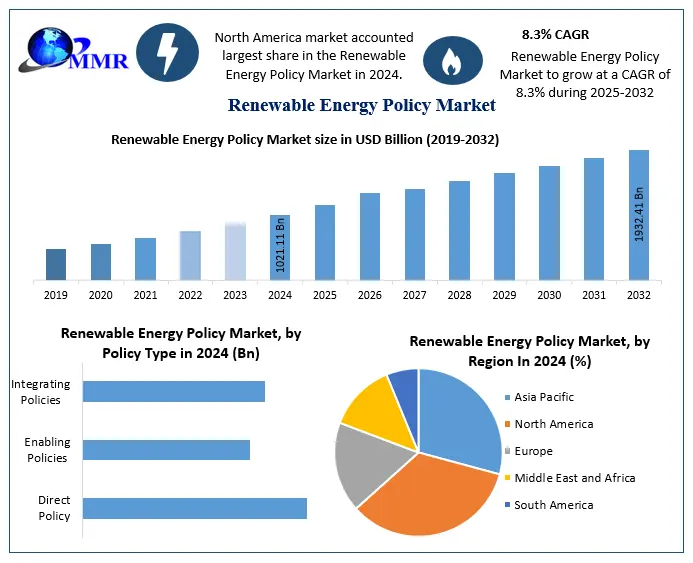
Renewable Energy Policy Market: Driving a Sustainable Future Through Strategic Regulations
Introduction
As the world shifts towards a cleaner and more sustainable energy future, renewable energy policies play a crucial role in accelerating this transformation. Governments and organizations worldwide are introducing incentives, subsidies, and regulatory frameworks to boost the adoption of solar, wind, hydro, and bioenergy solutions.
The Renewable Energy Policy Market is growing rapidly as nations commit to net-zero emissions, carbon neutrality, and climate goals. With strong policies in place, renewable energy is becoming more affordable, accessible, and mainstream.
This blog explores key trends, challenges, opportunities, and frequently asked questions about the Renewable Energy Policy Market. Whether you’re an investor, policymaker, business leader, or environmental advocate, this guide will provide valuable insights into the future of clean energy.
Curious about the market dynamics? Get a free sample to explore the latest insights here:https://www.maximizemarketresearch.com/request-sample/200155/
Understanding the Renewable Energy Policy Market
What Is Renewable Energy Policy?
Renewable energy policy refers to the regulations, incentives, and strategies implemented by governments to promote the adoption of renewable energy sources. These policies aim to:
✔ Reduce reliance on fossil fuels
✔ Encourage private and public investment in renewables
✔ Ensure energy security and sustainability
✔ Achieve climate goals and emission reductions
Why Are Renewable Energy Policies Important?
✅ Accelerates Clean Energy Transition: Incentives encourage businesses and homeowners to adopt renewables.
✅ Reduces Carbon Emissions: Helps countries meet international climate agreements like the Paris Agreement.
✅ Enhances Energy Security: Decreases dependence on imported fossil fuels.
✅ Boosts Economic Growth: Creates jobs in the renewable energy sector.
✅ Encourages Technological Innovation: Supports R&D in next-gen renewable technologies.
With climate change concerns growing, governments worldwide are prioritizing renewable energy policies to ensure a cleaner future.
Market Overview & Growth Trends
📈 The Renewable Energy Policy Market is expected to grow at a CAGR of XX% from 2024 to 2030, reaching USD XX billion by 2030.
Key Growth Drivers
🔹 Global Climate Agreements: Policies like the Paris Agreement push countries to adopt clean energy.
🔹 Declining Renewable Energy Costs: Solar and wind power costs have fallen by over 80% in the last decade.
🔹 Government Incentives & Tax Credits: Financial support for renewable projects boosts investment.
🔹 Rising Energy Demand: Clean energy solutions are needed to meet growing energy consumption.
🔹 Technological Advancements: Innovations in energy storage, smart grids, and hydrogen support policy goals.
Leading economies like the U.S., China, the EU, and India are aggressively expanding their renewable energy policies to achieve net-zero emissions by 2050.
To Gain More Insights into the Market Analysis, Browse Summary of the Research Report:https://www.maximizemarketresearch.com/market-report/renewable-energy-policy-market/200155/
Types of Renewable Energy Policies
1. Feed-in Tariffs (FiTs)
✔ Fixed payments to renewable energy producers for electricity supplied to the grid.
✔ Encourages investment in small-scale solar, wind, and bioenergy projects.
2. Renewable Portfolio Standards (RPS)
✔ Requires utilities to source a specific percentage of their energy from renewables.
✔ Drives demand for solar, wind, and hydroelectric power.
3. Net Metering Policies
✔ Allows homeowners and businesses to sell excess solar power back to the grid.
✔ Provides financial benefits for rooftop solar panel owners.
4. Tax Incentives & Subsidies
✔ Governments offer tax credits, rebates, and low-interest loans for renewable energy projects.
✔ Reduces the upfront cost of solar and wind installations.
5. Carbon Pricing & Emissions Trading
✔ Introduces carbon taxes to discourage fossil fuel use.
✔ Promotes clean energy investments through carbon credit trading.
By implementing these policies, governments create a stable and attractive market for renewable energy investments.
Frequently Asked Questions (FAQs)
1. How Do Renewable Energy Policies Impact Businesses?
Businesses benefit from lower energy costs, tax credits, and sustainability incentives. Many companies are adopting corporate renewable energy targets to comply with regulations and meet ESG (Environmental, Social, and Governance) goals.
2. Which Countries Have the Best Renewable Energy Policies?
🌍 Top Leaders:
-
Germany – Strong FiTs and ambitious climate targets.
-
China – Largest global investor in renewable energy.
-
United States – Federal tax credits and state-level RPS.
-
Denmark – Leading wind energy policies.
3. What Are the Challenges in Implementing Renewable Energy Policies?
🔺 Grid Integration Issues – Upgrading infrastructure to handle intermittent renewable power.
🔺 High Initial Costs – Despite falling prices, upfront investment can be a barrier.
🔺 Policy Uncertainty – Frequent changes in government policies create market instability.
4. How Do Renewable Energy Policies Affect Energy Prices?
In the short term, policy-driven investments may increase costs. However, in the long run, renewables lower electricity prices due to cheap operational costs.
5. What Is the Future of Renewable Energy Policies?
🚀 Expect stronger carbon pricing, higher renewable targets, and increased government support for storage technologies like hydrogen and advanced batteries.
Challenges & Solutions in Renewable Energy Policy Implementation
| Intermittency of renewables | Invest in energy storage and smart grids |
| Resistance from fossil fuel industries | Introduce fair transition policies for workers |
| Slow policy implementation | Improve government-private sector collaboration |
| High capital costs | Expand low-interest financing programs |
Governments and businesses must work together to overcome these barriers and accelerate the clean energy revolution.
Future Trends & Innovations in Renewable Energy Policy
🌍 Green Hydrogen: Policies promoting hydrogen as a clean fuel alternative.
🔋 Advanced Energy Storage: Incentives for battery storage and pumped hydro.
💡 Digitalization: AI-driven energy management solutions.
🏭 Corporate Renewable Energy Targets: More businesses adopting 100% clean energy goals.
⚡ Electrification of Transportation: Policies supporting EV infrastructure expansion.
These trends will shape the renewable energy policy landscape over the next decade.
Conclusion
The Renewable Energy Policy Market is fundamental to the global transition toward sustainable energy. Strong government policies drive investment, innovation, and widespread adoption of renewable energy.
With climate goals becoming more ambitious, the future of renewable energy policies will focus on scalability, affordability, and integration.
💡 The time to invest in renewable energy is NOW! Governments, businesses, and individuals must embrace these policies to secure a cleaner, greener future.







